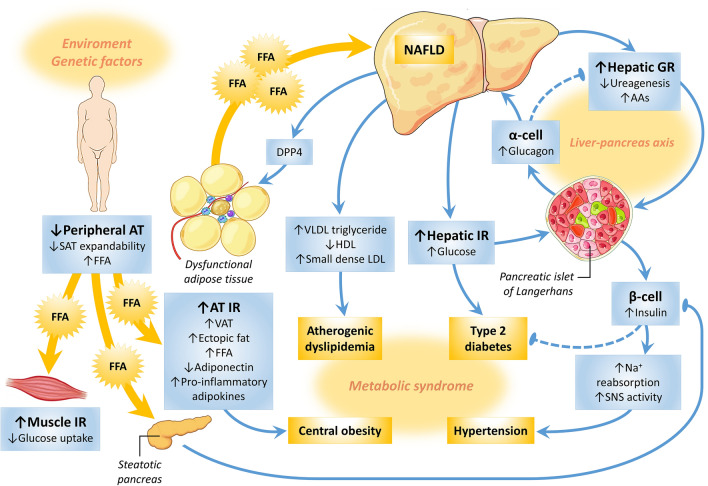Fig. 1.
Pathophysiology of NAFLD as a continuum from obesity to metabolic syndrome and diabetes. Environmental factors affect the expression of genes, inducing weight gain. When the capacity of expansion of subcutaneous adipose tissue (AT) is reached, an increased free fatty acids (FFAs) mobilization arises, resulting in visceral and ectopic fat deposition. One ectopic site is the muscle, where increased FFAs deposition promotes insulin resistance (IR), inhibiting insulin-mediated glucose uptake. On the other hand, AT insulin resistance facilitates lipolysis and increases the flux of FFAs to the liver, inducing hepatic IR and enhancing glucose production, de novo hepatic lipogenesis, VLDL release and atherogenic dyslipidemia. FFAs spill over into the pancreas, causing β-cell dysfunction by lipotoxicity, hyperglycemia and diabetes (the twin cycle hypothesis). Increased liver fat also promotes hepatic glucagon resistance (GR) over the amino acids (AAs) metabolism, reducing ureagenesis and resulting in hyper-aminoacidemia. Increased AAs stimulate glucagon production to compensate for hepatic GR, and a vicious cycle is installed (the liver-pancreas axis). This hyperglucagonemia also leads to an increased hepatic glucose release. The globally IR state results in hyperinsulinemia, which may enhance sodium reabsorption and increase sympathetic nervous system activity, contributing to the hypertension. Inflamed dysfunctional AT becomes more insulin resistant and releases pro-inflammatory adipokines, while decreases anti-inflammatory adiponectin. In the liver, triglycerides and toxic metabolites induce lipotoxicity, mitochondrial dysfunction and endoplasmic reticulum stress, leading to hepatocyte damage, apoptosis and fibrosis. These dysfunctional hepatocytes synthesize and secret the dipeptidyl peptidase 4 (DPP4), which promotes inflammation of AT macrophages and more IR. AAs amino acids, AT adipose tissue, DPP4 dipeptidyl peptidase 4, FFA free fatty acid, GR glucagon resistance, HDL high-density lipoprotein, IR insulin resistance, LDL low-density lipoprotein, NAFLD nonalcoholic fatty liver disease, SAT subcutaneous adipose tissue, SNS sympathetic nervous system, VAT visceral adipose tissue, VLDL very low-density lipoprotein. Pointed arrows indicate stimulation or enhancement, while blunt ends indicate inhibition or repression. Dashed arrows indicate progressive reduction in a pathway

